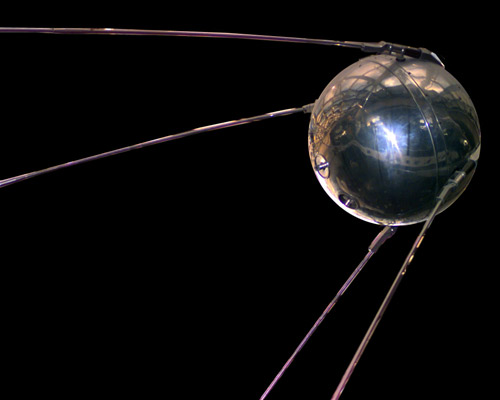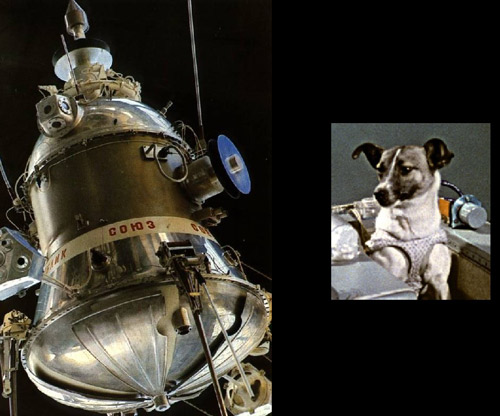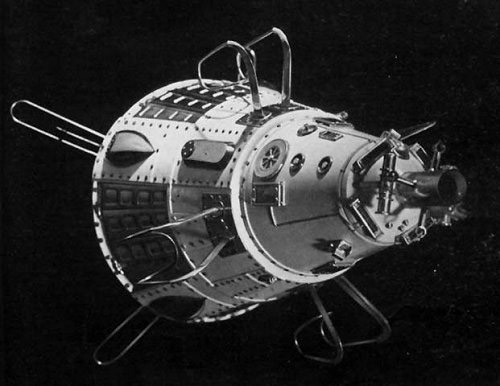Sunday, January 11, 2009
A series of satellites launched by the Soviet Union at the dawn of the Space Age. “Sputnik” (satellite) was the abbreviated Western name for these spacecraft, known in Russia generically as Iskusstvenniy Sputnik Zemli (Artificial Earth Satellite).
Sputniks 1, 2, and 3 were launched during the International Geophysical Year, a period lasting from July 1, 1957, to December 31, 1958. Details of these satellites are given below. The spacecraft known in the West as Sputnik 4, 5, 6, 9, and 10 were announced at the time in Russia as Korabl-Sputnik 1, 2, 3, 4, and 5. These were unmanned test launches of the Vostok space capsule which would eventually carry Yuri Gagarin on his historic flight. Sputnik 7 and 8 were Venus probes.
Sputnik 1
 |
The first spacecraft to be placed in orbit around the Earth. A basket-ball-sized (59-cm) aluminum sphere with four trailing spring-loaded antennae, it carried a small radio beacon that beeped at regular intervals and could verify, by telemetry, exact locations on the Earth’s surface. It decayed three months after launch.
As a technical achievement, Sputnik caught the world's attention and the American public off-guard. Its size was more impressive than Vanguard's intended 7.7-kg (3.5-pound) payload. In addition, the public feared that the Soviets' ability to launch satellites also translated into the capability to launch ballistic missiles that could carry nuclear weapons from Europe to the U.S.
Immediately after the Sputnik 1 launch in October, the U.S. Defense Department responded to the political furor by approving funding for another U.S. satellite project. As a simultaneous alternative to Vanguard, Wernher von Braun and his Army Redstone Arsenal team began work on the Explorerproject.
Sputnik 2
 |
Sputnik 2 was a 4-meter high cone-shaped capsule with a base diameter of 2 meters. It contained several compartments for radio transmitters, a telemetry system, a programming unit, a regeneration and temperature control system for the cabin, and scientific instruments. A separate sealed cabin contained the experimental dog Laika. Engineering and biological data were transmitted using the Tral D telemetry system, which would transmit data to Earth for 15 minutes of each orbit. Two spectrophotometers were on board for measuring solar radiation (ultraviolet and X-ray emissions) and cosmic rays. A television camera was mounted in the passenger compartment to observe Laika.
Sputnik 2 was launched on a Sapwood SS-6 8K71PS launch vehicle (essentially a modified R-7 ICBM similar to that used for Sputnik 1) into a 212 × 1660 km orbit with a period of 103.7 minutes. After reaching orbit the nose cone was jettisoned successfully but the Blok A core did not separate as planned. This inhibited the operation of the thermal control system. Additionally some of the thermal insulation tore loose so the interior temperatures reached 40°C. It is believed Laika survived for only about two days instead of the planned ten because of the heat. The orbit of Sputnik 2 decayed and it reentered Earth's atmosphere on April 14, 1958 after 162 days in orbit.
Sputnik 3
 |
| Spacecraft | Launch date | Orbit | Mass (kg) |
| Sputnik 1 | Oct. 4, 1957 | 228 × 947 km | 83.6 |
| Sputnik 2 | Nov. 3, 1957 | 225 × 1,671 km | 508 |
| Sputnik 3 | May 15, 1958 | 230 × 1,880 km | 1,327 |
0 comments:
Post a Comment